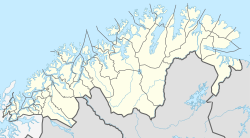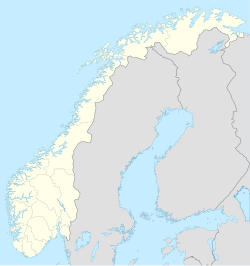world.wikisort.org - Norway
![]() Karasjok (Norwegian), Kárášjohka (Northern Sami), or Kaarasjoki (Kven) is the administrative centre of Karasjok Municipality in Troms og Finnmark county, Norway. The village is located along both sides of the Karasjohka river, just 12 kilometres (7.5 mi) west of the Norway-Finland border. The European route E06 highway runs through the village on its way from Lakselv to Tana bru and Kirkenes. The 2.19-square-kilometre (540-acre) village has a population (2017) of 1,844 which gives the village a population density of 842 inhabitants per square kilometre (2,180/sq mi).[1]
Karasjok (Norwegian), Kárášjohka (Northern Sami), or Kaarasjoki (Kven) is the administrative centre of Karasjok Municipality in Troms og Finnmark county, Norway. The village is located along both sides of the Karasjohka river, just 12 kilometres (7.5 mi) west of the Norway-Finland border. The European route E06 highway runs through the village on its way from Lakselv to Tana bru and Kirkenes. The 2.19-square-kilometre (540-acre) village has a population (2017) of 1,844 which gives the village a population density of 842 inhabitants per square kilometre (2,180/sq mi).[1]
Village | |
 View of the historic church in the village | |
| Coordinates: 69.4719°N 25.5112°E | |
| Country | Norway |
| Region | Northern Norway |
| County | Troms og Finnmark |
| District | Vest-Finnmark |
| Municipality | Karasjok |
| Area | |
| • Total | 2.19 km2 (0.85 sq mi) |
| Elevation | 141 m (463 ft) |
| Population (2017)[1] | |
| • Total | 1,844 |
| • Density | 842/km2 (2,180/sq mi) |
| Time zone | UTC+01:00 (CET) |
| • Summer (DST) | UTC+02:00 (CEST) |
| Post Code | 9730 Karasjok |
The village is an important centre in the municipality and region. About 2/3 of the municipal population lives in the village. The Sami Parliament of Norway is located in the village. It acts as an institution of cultural autonomy for the indigenous Sami people in Norway. The Old Karasjok Church and the newer Karasjok Church are located in the village. The newer church is also the seat of the Indre Finnmark prosti (deanery) of the Church of Norway.[3]
History
Prior to the beginning of the 1700s, there might not have been a permanent population there but the area was used by nomads.[3]
World War II
During World War II a Nazi concentration camp was built in Karasjok: Lager IV Karasjok (German for "Karasjok Camp No.4", Norwegian: Karasjok fangeleir).[4][5] The camp was run by SS, and it was among[6] the first four Nazi concentration camps in Northern Norway.
In July 1943, 374 political prisoners and POWs prisoners (mostly Yugoslavs) were brought to the concentration camp. They were tasked with widening the road to Karigasniemi, Finland. After four or five months, only 111 of these prisoners were still alive. At the end of the prisoners' stay in Karasjok, before transportation out of Karasjok, 45 prisoners were massacred by the firing of small arms.[7] At least one former prisoner is (as of 2013) still alive.[8]
After World War II
In 2015, the second edition of Sápmi Pride, the LGBT pride festival, was held in Karasjok. To protest homosexuals attending the Karasjok Church, and to protest that a female priest held the services, Norges Samemisjon cancelled one of their radio broadcasts.[9]
References
- Statistisk sentralbyrå (1 January 2017). "Urban settlements. Population and area, by municipality".
- "Karasjok, Karasjok (Finnmark)". yr.no. Retrieved 2018-07-03.
- Dalfest, Terje; Askheim, Svein, eds. (2017-10-25). "Karasjok". Store norske leksikon (in Norwegian). Kunnskapsforlaget. Retrieved 2018-07-03.
- Bakke Styrvold, Sigurd. "Heil og Sæl. Jeg er utdannet morder!" - Den norske SS Vaktbataljon 1942 – 45" (PDF). MA in History - University of Oslo (in Norwegian): 14.
- Richter, Timm C. (2006). Krieg und Verbrechen: Situation und Intention: Fallbeispiele (in German). p. 114. ISBN 9783899750805.
- Bakke Styrvold, Sigurd. "Heil og Sæl. Jeg er utdannet morder!" - Den norske SS Vaktbataljon 1942 – 45" (PDF). MA in History - University of Oslo (in Norwegian): 14.
Det fantes på forskjellige tidspunkter flere serberleire i Norge, men de norske vaktene gjorde bare tjeneste i de fire første; Lager I Beisfjord, Lager II Elsfjord, Lager III Rognan (også kjent som Botn) og Lager IV Karasjok
- Linde, Marte (2014-11-08). "Disse fangene bygget "blodveien" – og så ble de henrettet" [These prisoners built 'the blood road' - and then they were executed]. NRK Troms (in Norwegian). Retrieved 2018-07-03.
- Larsen, Dan Robert (2013-05-24). "Følelsesladet møte med Karasjok". NRK Sápmi (in Norwegian). Retrieved 2018-07-03.
- Larsen, Dan Robert (2016-06-02). "Flytter Sápmi Pride til Kautokeino". NRK Sápmi (in Norwegian). Retrieved 2018-07-03.
See also
- Prison camps in North Norway during World War Two
Другой контент может иметь иную лицензию. Перед использованием материалов сайта WikiSort.org внимательно изучите правила лицензирования конкретных элементов наполнения сайта.
WikiSort.org - проект по пересортировке и дополнению контента Википедии

